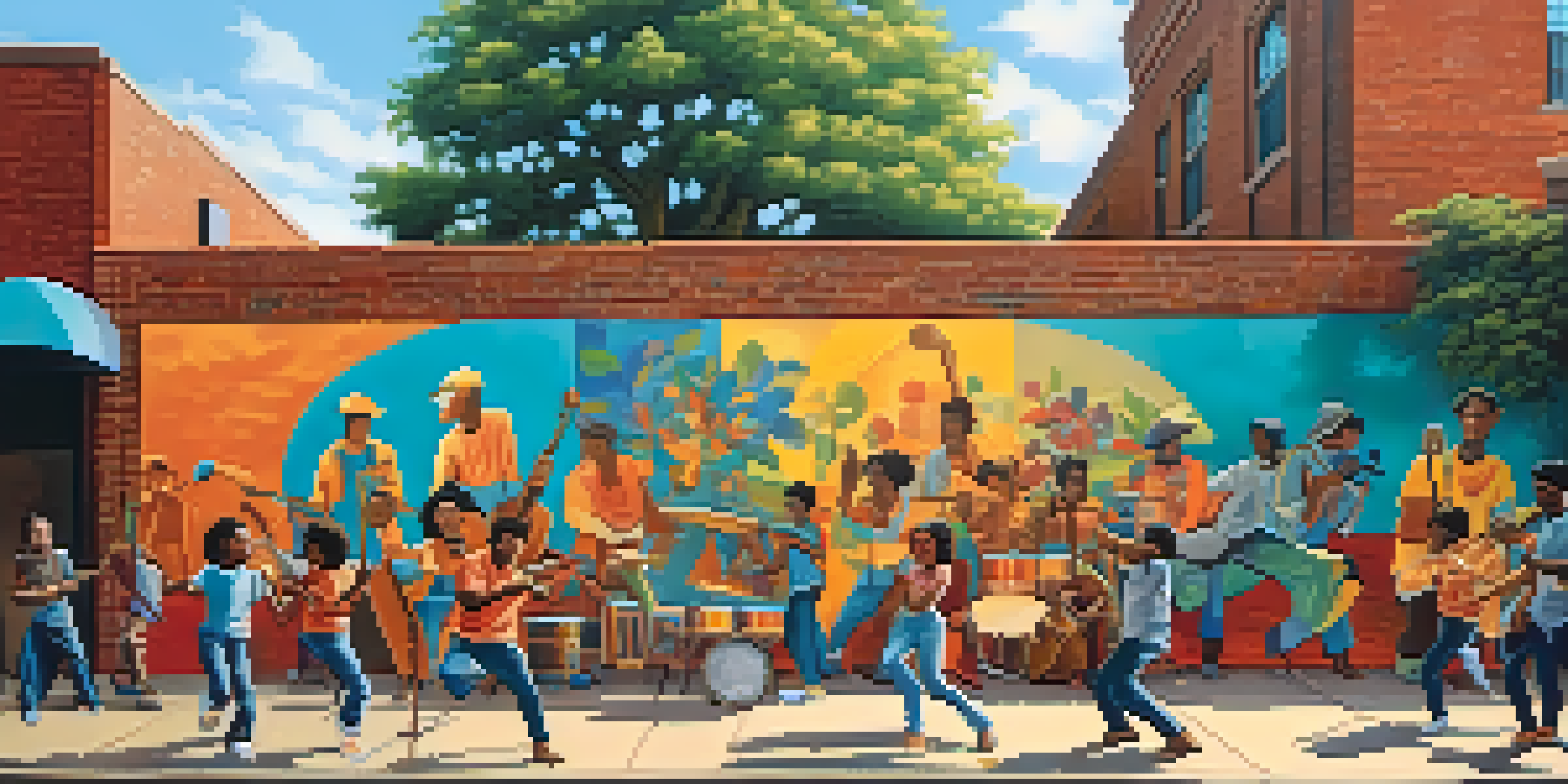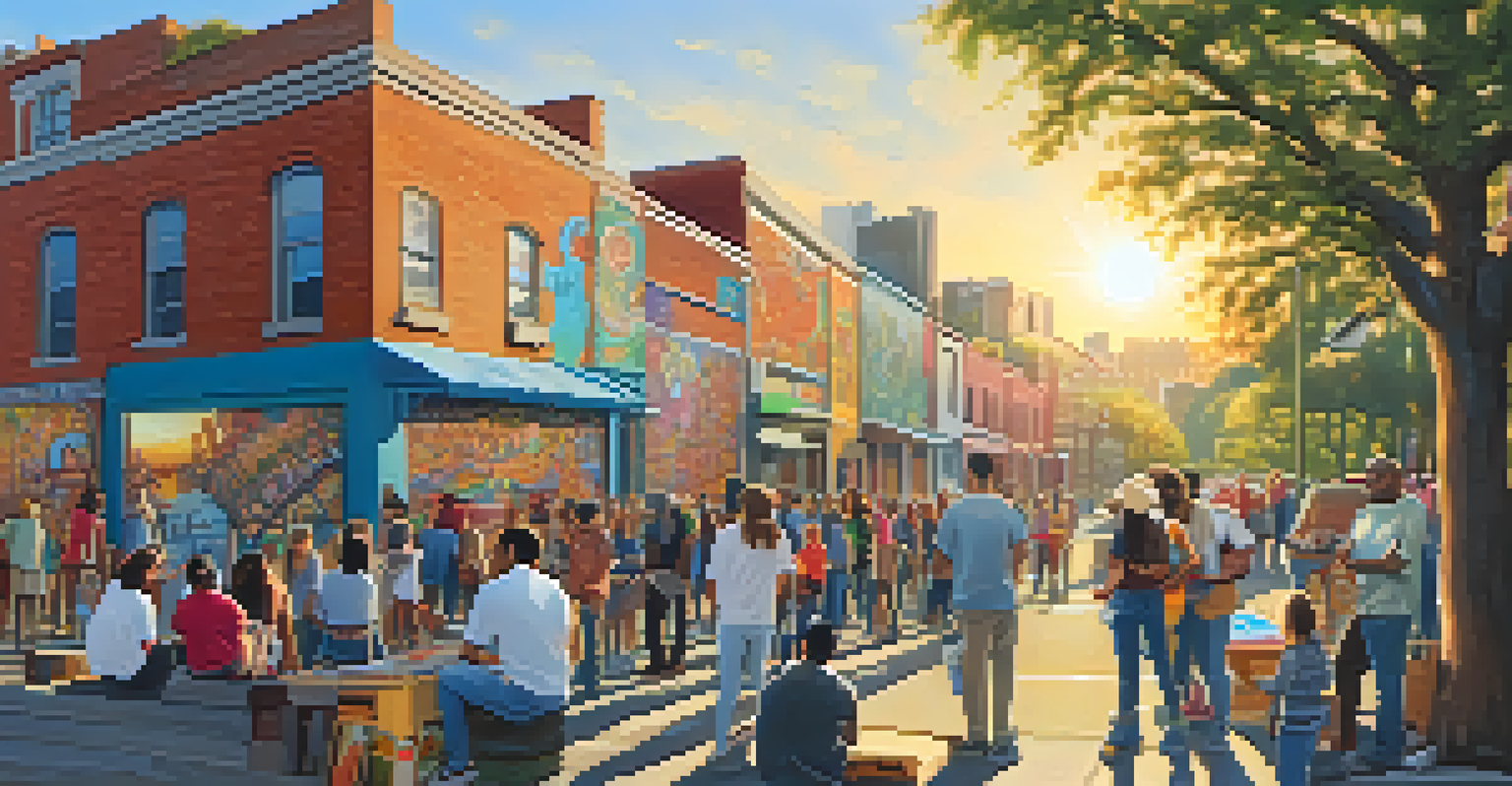Public Perception: Street Art vs. Graffiti in Modern Culture

Defining Street Art and Graffiti: What’s the Difference?
At first glance, street art and graffiti might seem synonymous, but they embody different philosophies and purposes. Street art typically refers to visual artwork created in public spaces, often with permission, that aims to provoke thought or beautify an area. In contrast, graffiti often involves unauthorized markings or designs, which can be seen as vandalism rather than art.
Art is not a mirror to reflect the world, but a hammer with which to shape it.
This distinction can be crucial when considering public perception. Street art is often celebrated for its aesthetic and social messages, while graffiti may be viewed as a nuisance or an act of rebellion. However, both forms are expressions of culture and identity in urban environments, sparking ongoing debates about art's role in public spaces.
Understanding these definitions helps frame the conversation about public perception, allowing us to appreciate the nuances of each form. While street art can beautify a neighborhood, graffiti can challenge societal norms. Both contribute to the rich tapestry of modern culture, but how they are perceived often depends on context and intention.
The Rise of Street Art: From Vandalism to Gallery
Over the past few decades, street art has gained significant recognition and respect within the art community. Artists like Banksy and Shepard Fairey have transformed the perception of street art, showcasing it in galleries and exhibitions. This shift has elevated street art from being dismissed as vandalism to being revered as a legitimate form of artistic expression.

With this newfound respect comes a growing appreciation from the public. Many cities are now commissioning street artists to create murals, recognizing their ability to enliven urban spaces and engage communities. This change in perception reflects a broader trend where art is seen as a vehicle for social change, making street art not just acceptable, but desirable.
Art vs. Vandalism: Key Distinction
Street art is often celebrated for its positive social messages, while graffiti is frequently viewed as vandalism, highlighting the importance of context and intention.
However, the transition from the streets to the gallery has sparked debate. Some purists argue that street art's essence is tied to its spontaneous and unauthorized nature. As street art becomes commercialized, it raises questions about authenticity and the potential loss of its grassroots spirit.
Graffiti: The Rebel Spirit of the Streets
Graffiti has long been associated with rebellion, often seen as a voice for the voiceless in society. It serves as a powerful medium for marginalized communities to express their frustrations, dreams, and identities. This raw, emotional connection can make graffiti a compelling form of art, even if it doesn't conform to traditional standards.
Graffiti is a way of telling the world, 'I am here.'
Despite its negative connotations, graffiti can also play a significant role in community identity. Many neighborhoods embrace graffiti as a symbol of resistance and cultural pride. Murals and tags can tell stories of struggle and triumph, transforming urban landscapes into canvases of lived experience.
However, public perception of graffiti remains complicated. While some view it as art, others see it as defacement. This dichotomy can lead to legal repercussions for graffiti artists, often forcing them to navigate a fine line between expression and legality.
Cultural Influences: How Media Shapes Perception
Media plays a crucial role in shaping public perception of both street art and graffiti. Documentaries, news coverage, and social media can highlight the beauty and significance of these art forms, influencing how communities view them. Positive portrayals can foster appreciation, while sensationalized stories can perpetuate negative stereotypes.
For instance, when a city commissions a mural, media coverage often highlights the artist's story and the mural's impact on the community. This can lead to increased support and funding for similar projects. Conversely, when graffiti is portrayed solely as vandalism, it can spark calls for stricter laws and crackdowns.
Community Shapes Art Perception
Engaging local residents in street art and graffiti projects fosters a sense of ownership and pride, helping to demystify these art forms and enhancing their value in reflecting community identity.
As the digital landscape continues to evolve, social media platforms allow artists to showcase their work and connect with audiences directly. This democratization of art can shift perceptions, as viewers engage with the stories behind the pieces, inviting them to see graffiti and street art through a more informed lens.
The Global Perspective: Street Art and Graffiti Worldwide
Street art and graffiti manifest differently across the globe, influenced by local cultures, politics, and histories. In some cities, like Berlin, graffiti is celebrated as a form of expression and resistance, while in others, like Singapore, it faces strict regulations and penalties. These variations reflect how public perception is shaped by cultural context.
In many places, street art serves as a tool for social and political commentary. Artists use their work to address issues such as inequality, environmental concerns, and human rights. This global perspective highlights how street art and graffiti can transcend borders and connect communities through shared struggles and aspirations.
Moreover, international festivals and events celebrating street art have emerged, fostering collaboration and dialogue among artists worldwide. These gatherings not only elevate the art form but also challenge negative perceptions by showcasing the talent and creativity within this dynamic field.
The Role of Community: Bridging the Gap
Community involvement is essential in shaping public perception of street art and graffiti. When local residents are engaged in the creation and maintenance of art in their neighborhoods, it fosters a sense of ownership and pride. This collaborative approach can transform once-neglected spaces into vibrant hubs of creativity and expression.
Initiatives like community mural projects or graffiti workshops encourage participation from diverse groups, bridging gaps between artists and residents. This collaboration not only beautifies the area but also helps demystify the art forms, showcasing their value in reflecting community identity.
Global Variations in Art Expression
Street art and graffiti differ worldwide, influenced by local cultures and politics, showcasing how these forms can serve as powerful tools for social commentary and community connection.
However, it's vital to navigate these projects carefully. Ensuring that the voices of the community are heard is crucial to avoid the commercialization of street art, which can alienate local artists. By prioritizing community input, cities can cultivate an appreciation for both street art and graffiti that honors their roots.
The Future of Street Art and Graffiti: Trends and Predictions
As street art and graffiti continue to evolve, their future is shaped by technological advancements and societal changes. Digital tools are increasingly being used to create and share art, allowing for innovative expressions that merge physical and virtual spaces. Artists are exploring augmented reality and interactive installations, pushing the boundaries of traditional street art.
Moreover, as social movements gain momentum, both street art and graffiti are likely to remain powerful forms of expression. Artists will continue to address pressing issues, reflecting the collective consciousness of society. This adaptability ensures that these art forms remain relevant and resonate with audiences.

Ultimately, the future of street art and graffiti hinges on public perception. As communities recognize the value of these expressions, there may be a growing push for support and acceptance. Embracing the artistic spirit of our streets can lead to vibrant, inclusive urban environments that celebrate creativity.